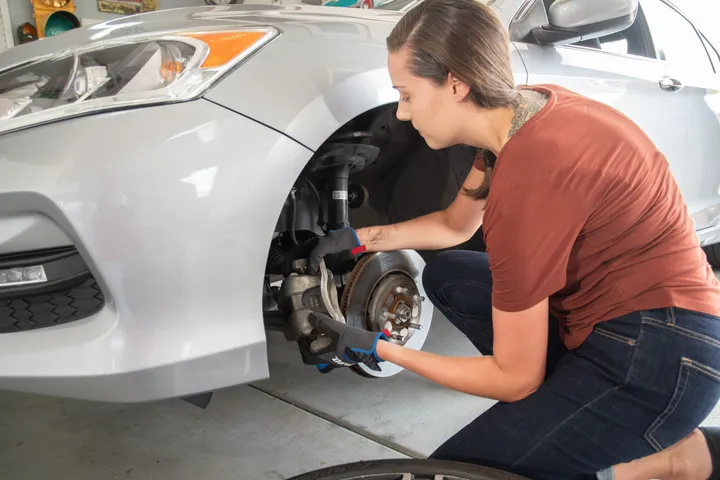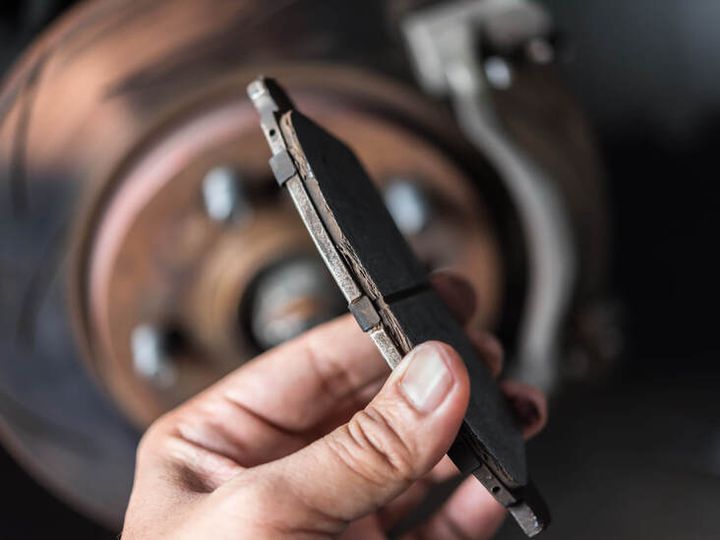


Brake pads are a critical component of a vehicle's braking system, responsible for creating the necessary friction to slow down and stop the vehicle. Their importance in ensuring safety cannot be overstated, as they play a crucial role in preventing accidents and protecting the lives of drivers, passengers, and pedestrians.
Stopping Power: Brake pads are designed to convert the kinetic energy of a moving vehicle into heat energy through friction, allowing the vehicle to decelerate and come to a complete stop. Without properly functioning brake pads, a vehic le's stopping distance would be significantly increased, increasing the risk of collisions. Control and Stability: In addition to stopping power, brake pads also contribute to the overall control and stability of a vehicle during braking. Worn or damaged brake pads can cause uneven braking, leading to potential loss of control or skidding, especially in emergency situations.
Brake System Protection: Brake pads act as a sacrificial component within the braking system, designed to wear down over time. By replacing worn brake pads, you protect other components of the braking system, such as rotors and calipers, from excessive wear and potential damage.

Before we dive into the repair process and costs, let's explore the primary reasons why brake pads need to be replaced:
| Cause | Description |
|---|---|
| Normal Wear and Tear | Brake pads are designed to wear down over time due to the constant friction against the rotors during braking. This is an inevitable part of the braking process. |
| Uneven Wear | Issues like stuck calipers, misalignment, or problems with the brake hardware can cause the pads to wear unevenly, leading to premature replacement. |
| Contamination and Damage | Leaking brake fluid, overheating due to aggressive braking, or debris can contaminate or damage the friction material on the pads, rendering them ineffective before their expected lifespan. |
As you can see, while normal wear and tear is unavoidable, there are several other factors that can accelerate the degradation of your brake pads. Addressing these underlying issues is crucial to ensure optimal braking performance and extend the life of your brake components.
Knowing when it's time to replace your brake pads is essential for your safety and the longevity of your braking system. Here are the telltale signs to watch out for:
Noise: A high-pitched squealing or grinding sound when you apply the brakes is a surefire indicator that your pads are dangerously thin. Many pads have built-in wear indicators that make contact with the rotors when the pads are worn down, causing that telltale squeal.
Vibrations and Pulsations: If you experience vibrations or pulsations in the brake pedal when braking, it could be a sign that the pads are worn unevenly or that the rotors are grooved or warped due to excessive pad wear.
Reduced Braking Performance: If it takes longer to stop or if the brake pedal feels mushy or unresponsive, it's a clear indication that your brakes need attention, and the pads may need to be replaced.
Ignoring these warning signs can lead to more severe and costly issues, such as damage to the rotors or other brake components. It's always better to address brake pad wear promptly to ensure your safety on the road.
Now that you know the signs of worn brake pads, let's dive into the repair process. Here's a step-by-step guide to what you can expect:
Caliper Removal: The first step is to remove the caliper (the part that houses the brake pads) from the rotor. This involves disconnecting the brake line and removing a few bolts or pins, depending on your vehicle.
Pad Removal and Inspection: With the caliper off, we can slide out the old, worn-out brake pads and take a close look at the condition of the caliper and mounting hardware. Any debris, corrosion, or damage must be addressed to ensure proper operation with the new pads.
Cleaning and Preparation: Thorough cleaning and inspection of the caliper and mounting hardware are crucial to ensure a smooth installation of the new pads. Any contaminants or issues can cause problems down the line.
Pad Installation: With everything cleaned and inspected, we can then slide in the new brake pads, making sure they're properly seated and aligned. Using the correct type of brake pad for your vehicle is essential for optimal braking performance and longevity.
Rotor Inspection and Replacement (if needed): While the wheels are off, we'll inspect the rotors for grooves, warping, or excessive wear. If the rotors are beyond a certain point of wear, they may need to be resurfaced or replaced entirely to ensure proper braking and prevent premature pad wear.
Brake Fluid Flush (if needed): If the brake fluid appears contaminated or hasn't been changed in a while, we'll likely recommend a complete brake fluid flush. Contaminated fluid can cause a host of issues, including premature pad wear and caliper sticking.
Caliper Inspection and Repair/Replacement (if needed): During the inspection process, we'll also check for any issues with the calipers, such as sticking, leaking, or other problems. If necessary, we may recommend rebuilding or replacing the calipers to ensure proper operation and prevent further damage to the new pads.
Reassembly and Bleeding: Once all components have been inspected, cleaned, and replaced as needed, we'll reassemble the braking system and bleed the brake lines to remove any air pockets.
Test Drive and Bedding Procedure: After the repair is complete, we'll take the vehicle for a test drive and perform a proper bedding procedure. This process involves a series of light braking applications to gradually mate the new pads to the rotors, ensuring optimal braking performance and longevity.
Throughout the repair process, we'll keep you informed and address any additional issues that may arise. Our goal is to ensure your braking system is operating at peak performance and that you can drive with confidence and peace of mind.

While brake pad replacement is an inevitable part of vehicle maintenance, there are several steps you can take to extend the life of your brakes and prevent premature wear:
Follow Recommended Replacement Intervals: Most manufacturers recommend replacing brake pads somewhere between 25,000 and 70,000 miles, depending on your driving habits and the type of pads you have. Adhering to these guidelines can help you avoid costly repairs down the line.
Regular Brake Inspections: Having your brakes inspected regularly, even if you're not experiencing any issues, can help catch potential problems early on, before they turn into major (and more expensive) repairs.
Proper Bedding Procedure: After replacing your brake pads, be sure to follow the proper bedding procedure to gradually mate the new pads to the rotors. Skipping this step can lead to premature wear and reduced braking performance.
Avoid Aggressive Braking: Slamming on the brakes from high speeds can cause the components to overheat, leading to glazed pads, warped rotors, and other issues. It's better to brake gently and give yourself plenty of stopping distance whenever possible.
By following these preventive measures, you can maximize the lifespan of your brake components and avoid costly repairs down the road.
Now, let's address the burning question: how much does a brake pad replacement cost? The answer can vary significantly depending on several factors:
| Factor | Description |
|---|---|
| Vehicle Make/Model | Pads for European and luxury vehicles tend to be more expensive than those for domestic or mainstream models. |
| Pad Type | There are three main types of brake pads: organic, semi-metallic, and ceramic. Ceramic pads are the most expensive but offer the longest lifespan and best performance. |
| Rotor Replacement | If your rotors need to be replaced due to excessive wear or warping, it can significantly increase the overall cost of the brake job. |
| Labor Rates | The labor rates at the repair shop can vary based on location, shop reputation, and other factors, affecting the overall cost of the repair. |
To give you a rough idea, here's a breakdown of typical brake pad replacement costs:
Pad Replacement Only (per axle): $115 - $270 for parts and labor at a shop
Pad and Rotor Replacement (per axle): $250 - $500
Complete Brake Job (all four wheels): $500 - $1,000 or more, depending on the extent of the repairs needed
Many shops also offer brake service packages that bundle pad replacement, rotor resurfacing or replacement, a brake fluid flush, and sometimes even a warranty. These packages can range from $200 to $500 or more per axle, depending on the shop and the services included.
If you're handy with tools and have the necessary knowledge, you can save a significant amount of money by doing the brake job yourself. A set of pads and rotors for a typical passenger vehicle might only cost $100 to $300 or so for the parts. However, keep in mind that brake work requires specialized tools and expertise, so it's not a job for the faint of heart.
Well, there you have it, folks – the insider's guide to brake pad replacement costs and everything that goes into the process. As you can see, there's a lot more to it than just slapping on a new set of pads.
At the end of the day, brakes are one of the most critical safety systems on your vehicle, so it's not an area where you want to cut corners or skimp on quality. Sure, brake jobs can be expensive, but the cost of neglecting your brakes could be far greater.
My advice? Stay on top of your brake maintenance, address any issues promptly, and don't be afraid to invest in quality parts and professional labor when it comes to something as important as your brakes. Your safety (and the safety of those around you) is worth it.
And hey, if you ever have any questions or need some expert advice, don't hesitate to reach out to your friendly neighborhood mechanic. We're always happy to help keep you and your ride safe on the roads.
Happy motoring, my friends!
The cost is influenced by the vehicle make/model, brake pad quality (organic, semi-metallic, ceramic), and whether additional repairs like rotor resurfacing/replacement are needed. Labor rates at the repair shop also play a role.
No, cheap brake pads are usually lower quality and wear out faster, potentially compromising safety and requiring more frequent replacements.
It's recommended to replace brake pads on the same axle (front or rear) in pairs/sets for even wear and optimal braking performance.
Brake pad lifespan can vary from 25,000 to 70,000 miles depending on driving habits, vehicle type, and pad quality.
Not always, but rotors may need resurfacing or replacement if they are excessively worn, grooved or warped to prevent vibrations and uneven pad wear.
While possible for experienced DIYers, brake work is safety-critical so professional installation is highly recommended unless you have proper tools and knowledge.
Bedding allows new pads to gradually mate with rotors, preventing vibration, squealing and uneven wear for optimal braking performance.
Avoid aggressive braking, follow recommended service intervals, and have brakes inspected regularly to catch issues early.
Some noise like occasional squeaking is normal for new pads, but grinding, constant squealing or vibrations indicate an issue requiring inspection.
Yes, their regenerative braking systems put less strain on brake pads, potentially extending their lifespan compared to conventional vehicles.

Sarah isn't your average gearhead. With a double major in Mechanical Engineering and Automotive Technology, she dived straight into the world of car repair. After 15 years of turning wrenches at dealerships and independent shops, Sarah joined MICDOT to share her expertise and passion for making cars run like new. Her in-depth knowledge and knack for explaining complex issues in simple terms make her a valuable asset to our team.



